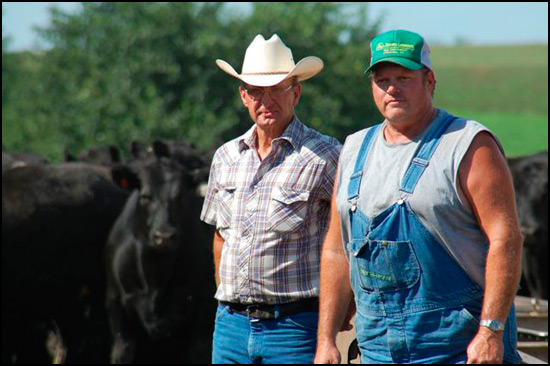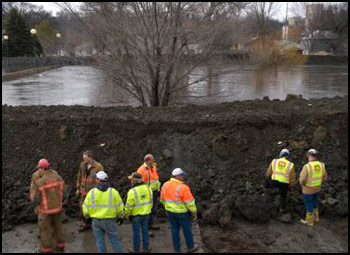
Eleven Years Later
CAB partners spent more than a decade building a commercial
Angus dynasty.
Instead of buying sale barn cattle, in 1997 John Osborn, Savannah, Mo., bought calves from neighbor Pete Mitts to go with his own. He later sold them on a value-based grid.
"It was our discovery year," Osborn says now. "We found out our cattle weren't any better than anybody else's." Barely 60% graded USDA Choice with a handful accepted for the Certified Angus Beef® (CAB®) brand. And 40% graded as Selects, "which you really don't want to sell on the grid," Mitts advises.
In a concerted effort to improve, the pair implemented a culling strategy. In 2009, Osborn Farms became a CAB-licensed feedlot drawing only from known sources, with all cattle owned by Mitts or Osborn. The latter had become a U.S. Premium Beef (USPB) member in 2007 and then an AngusSource®-approved process-verified program (PVP) feedyard. He only buys AngusSource-tagged calves with genetics that trace back to their herds.
Proof of what this pool of cattle can do, the feedlot easily won Northeast Region third-quarter honors in the AngusSource Carcass Challenge. The 43 head of mixed steers and heifers tallied 97.7% CAB and CAB Prime.
Read more about how Osborn and Mitts improved their offering.
Read more about their win in the AngusSource Carcass Challenge.
North Dakota's Tenacity
After spring snowstorms and flooding devastated the state, ranchers are rebuilding both their spirit and their livestock herds.

Valley City, ND, April 13, 2009 -- Members of the U.S.Army Corps of Engineers inspect the site of a levee where severe seepage threatens the integrity of the levee in downtown Valley City, ND. The Corps is working with city officials and the National Guard to ensure the safety of the levees in the town. Photo by Patsy Lynch/FEMA
.The spring flooding and successive blizzards that battered North Dakota in the last week of March 2009 will forever be etched in the memories of the ranch families who endured them.
For ranchers, it was a scene akin to a war zone: Record snowfalls through the winter caused flooding and ice jams across the state as the snow began to thaw in March. But then, as the floodwaters rose, Mother Nature played a cruel trick as a blizzard moved in to freeze the floodwaters and dump more snow; two additional blizzards quickly followed suit during those last days of March and the beginning of April. Cows were stranded — or drowned by ice jams and floodwaters, newborn calves died en masse, feed was inaccessible or already depleted from the long winter, and thousands of miles of fence were wiped out.
The statistics tallied when the storms stopped howling were inconceivable and unspeakable — nearly 100,000 cattle in the state were dead, a loss estimated at $55 million.
Today, North Dakota ranchers are slowly recovering from the losses, and like war veterans they are cautious about reliving the hellish events in detail. Instead, the story of the spring storms of 2009 is told in generalities, and North Dakota ranchers are focused on finding the good in the future ahead. Read more.

David Gazda
Association Perspective
Sound advice
Technology available in today’s cattle industry offers cattlemen a host of genetic selection tools. Artificial insemination (AI), ultrasound, embryo transfer (ET), DNA technology, and the use of expected progeny differences (EPDs) and performance records are but a few of the tools cattlemen may incorporate into their breeding programs to make better, more informed and accurate breeding decisions that will enhance the profitability of their operations.
However, one of the most underutilized resources available to cattlemen is that of the American Angus Association regional manager.
Association to Run Weekly Carcass Evaluation
Updated carcass trait EPDs available online, scheduled for weekly release.
The American Angus Association has issued its first release of genomic-enhanced expected progeny differences (EPDs) for multiple carcass traits. The data is now available at www.angus.org through AAA Login or the EPD/Pedigree lookup.
The updated National Cattle Evaluation (NCE) carcass trait EPDs are scheduled for weekly release and incorporate available breed-specific DNA profile results from the Igenity® Profile for Angus in addition to all pedigree and performance information.
Through the use of new technologies, Angus NCE EPDs can be provided across the complete performance database for carcass traits, encompassing nearly 2 million animals. In an industry first, genomic, carcass and ultrasound databases can be used to calculate NCE EPDs each week for Angus breeders and industry allies.
The process bypasses the need for interim procedures on animals with genomic profile results and speeds the information exchange for newly arriving ultrasound and carcass data received at the Association.
Visit www.angus.org to access the NCE genomic-enhanced EPDs for carcass traits. For more information call the Association at 816-383-5100 or e-mail the AHIR Department.
What’s Inside …
The October Angus Beef Bulletin EXTRA features several valuable articles, including specific sections devoted to management, marketing, and health and nutrition information. Select from the tabs at the top of the pageto access this month’s entire information-packed edition, a portion of which includes the following:
• BQA: A Way of Doing Business
• Instructions Cattlemen Can Use
• Optimize Meat Quality with Maximum Efficiency
• Know Your Ear Rots Before Feeding Grain to Livestock
• Results In for the AngusSource® Carcass Challenge Third Quarter
• Considerations for Retained Ownership
The Changing Face of the Animal Health Industry
What is it with the animal health industry? Just about the time livestock producers think they have a handle on product names and their suppliers, things change. A manufacturer combines with another to expand its product line, or one company buys out a competitor. Mergers and acquisitions seem to occur at an increasing rate. It gets confusing.
Old-timers might remember when O.M. Franklin was a leading name among animal health suppliers. Founded by the veterinarian credited with developing the first effective blackleg vaccine, the company's products once dominated the "vet supply" shelves of many rural drug stores. Other long-gone yet recognizable names of animal health product manufacturers include Anchor, Cutter or Norden. What happened to those and other product labels? Read more.
Sharing Food Safety's Role in World Peace
K-State welcomes military officers to educate them about food systems, safety and security.
"A secure food supply is essential to achieving peace in a global society," said Fred Cholick, dean of Kansas State University's (K-State's) College of Agriculture, in welcoming 113 military officers representing 80 different countries to K-State recently to learn more about food systems, safety and security.
Cholick, who is also director of K-State Research and Extension, possesses more than 30 years of experience with international food production. The international officers to whom he was speaking are participating in the Intermediate Level Education at the U.S. Army Command and General Staff College, said Mike Brettmann, field studies program director. Read more.
News Briefs …
• Ohio to Vote on Creation of Livestock Care Standards Board
• Michigan Governor Signs Bill Banning Crates, Stalls and Cages
• Salazar Seeks Congressional Support for Strategy to Manage Wild Horses
• Mexico Joins Canada in WTO Complaint Against U.S. COOL
• National Beef Files Registration Statement for Initial Public Offering of Class A Common Stock
• Nebraska Firm Recalls Beef Tongues
• Tennessee Study Defines New Market for Midwestern and Southeastern Farmers
Thou Shalt Not Kill ... Animals?
Truth in Food author Kevin Murphy takes exception to animal rights activists' use of Scripture to promote vegan lifestyle.
Before the speaker sat down and rested his case that eating animals for food was morally objectionable, he threw out one last barb, one last haymaker, that if it landed would surely do some damage, a kind of final assault on the audience's moral conscience that would have them fleeing the Egypt of food-animal production for the vegan promised land.
"Thou shalt not kill," he said, as he ended his presentation and returned to his seat alongside the other speakers.
If you haven't been exposed to animal activists, you might relegate this speaker to just an isolated incident. Yet it seems those advocating a vegan lifestyle are carrying this theme of "thou shalt not kill" forward with increased frequency. Read more.
[Click here to go to the top of the page.]







